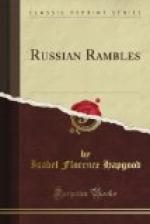Hither the Emperor and Empress come “to salute the Virgin,” on their safe return from a journey. Hither are brought imperial brides in gorgeous state procession—when they are of the Greek faith—on their way to the altar in the Winter Palace. We can never step into this temple without finding some deeply interesting and characteristically Russian event in progress. After we have run the inevitable gauntlet of monks, nuns, and other beggars at the entrance, we may happen upon a baptism, just beyond, the naked, new-born infant sputtering gently after his thrice-repeated dip in the candle-decked font, with the priest’s hand covering his eyes, ears, mouth, and nostrils, and now undergoing the ceremony of anointment or confirmation. Or we may come upon a bridal couple, in front of the solid silver balustrade; or the exquisite liturgy, exquisitely chanted by the fine choir in their vestments of scarlet, blue, and silver, with the seraphic wings upon their shoulders, and intoned, with a finish of art unknown in other lands, by priests robed in rich brocade. Or it may be that a popular sermon by a well-known orator has attracted a throng of listeners among the lofty pillars of gray Finland granite, hung with battle-flags and the keys of conquered towns. What we shall assuredly find is votaries ascending the steps to salute with devotion the benignant brown-faced Byzantine Virgin and Christ-Child, incrusted with superb jewels, or kneeling in “ground reverences,” with brow laid to the marble pavement, before the ikonostas, or rood-screen, of solid silver. Our Lady of Kazan has been the most popular of wonder-working Virgins ever since she was brought from Kazan to Moscow, in 1579, and transported to Petersburg, in 1721 (although her present cathedral dates only from 1811), and the scene here on Easter-night is second only to that at St. Isaac’s when the porticoes are thronged by the lower classes waiting to have their flower and candle decked cakes and cream blessed at the close of the Easter matins.
One of the few individual dwelling-houses which linger on the Nevsky Prospekt, and which presents us with a fine specimen of the rococo style which Rastrelli so persistently served up at the close of the eighteenth century, is that of the Counts Stroganoff, at the lower quay of the Moika. The Moika (literally, Washing) River is the last of the semicircular, concentric canals which intersect the Nevsky and its two radiating companion Prospekts, and impart to that portion of the city which is situated on the (comparative) mainland a resemblance to an outspread fan, whose palm-piece is formed by the Admiralty on the Neva quay.
The stately pile, and the pompous air of the big, gold-laced Swiss lounging at the entrance on the Nevsky, remind us that the Stroganoff family has been a power in Russian history since the middle of the sixteenth century.




